
Huntington is a town in Chittenden County, Vermont, United States. The population was 1,938 at the 2020 census.

Taxidermy is the art of preserving an animal's body via mounting or stuffing, for the purpose of display or study. Animals are often, but not always, portrayed in a lifelike state. The word taxidermy describes the process of preserving the animal, but the word is also used to describe the end product, which are called taxidermy mounts or referred to simply as "taxidermy". The word taxidermy is derived from the Greek words taxis and derma. Taxis means "arrangement", and derma means "skin". The word taxidermy translates to "arrangement of skin".

The American Museum of Natural History is a natural history museum on the Upper West Side of Manhattan in New York City. In Theodore Roosevelt Park, across the street from Central Park, the museum complex comprises 26 interconnected buildings housing 45 permanent exhibition halls, in addition to a planetarium and a library. The museum collections contain over 34 million specimens of plants, animals, fossils, minerals, rocks, meteorites, human remains, and human cultural artifacts, as well as specialized collections for frozen tissue and genomic and astrophysical data, of which only a small fraction can be displayed at any given time. The museum occupies more than 2 million square feet (190,000 m2). AMNH has a full-time scientific staff of 225, sponsors over 120 special field expeditions each year, and averages about five million visits annually.
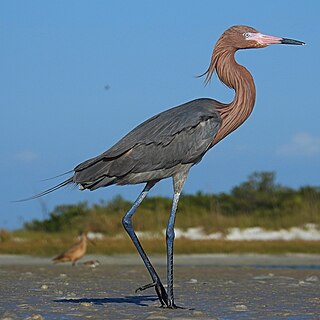
The reddish egret is a medium-sized heron. It is a resident breeder in Central America, The Bahamas, the Caribbean, the Gulf Coast of the United States, and Mexico. There is post-breeding dispersal to well north of the nesting range. In the past, this bird was a victim of the plume trade.

Missisquoi National Wildlife Refuge is a National Wildlife Refuge located in the eastern shore of Lake Champlain in the U.S. state of Vermont. The refuge is in Franklin County in the northwest corner of the state near the International Boundary with Canada. It is the only National Wildlife Refuge located entirely in Vermont, and is administered by the United States Fish and Wildlife Service.

The Denver Museum of Nature & Science is a municipal natural history and science museum in Denver, Colorado. It is a resource for informal science education in the Rocky Mountain region. A variety of exhibitions, programs, and activities help museum visitors learn about the natural history of Colorado, Earth, and the universe. The 716,000-square-foot (66,519 m2) building houses more than one million objects in its collections including natural history and anthropological materials, as well as archival and library resources.

The Royal Alberta Museum (RAM) is a museum of human and natural history in Edmonton, Alberta, Canada. The museum is located in Downtown Edmonton, north of City Hall. The museum is the largest in western Canada with more than 7,600 square metres (82,000 sq ft) exhibition space and 38,900 square metres (419,000 sq ft) in total.

Earthplace is a non-profit organization supported by donors and located in Westport, Connecticut. Its main focus is on building passion and respect for the natural world and a more sustainable future. Earthplace is a place that teaches people about science and nature conservation connected to it, while experiencing and learning about the natural world.
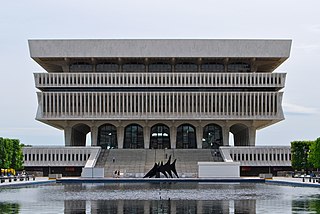
The New York State Museum is a research-backed institution in Albany, New York, United States. It is located on Madison Avenue, attached to the south side of the Empire State Plaza, facing onto the plaza and towards the New York State Capitol. The museum houses art, artifacts, and ecofacts that reflect New York’s cultural, natural, and geological development. Operated by the New York State Education Department's Office of Cultural Education, it is the oldest and largest state museum in the US. Formerly located in the State Education Building, the museum now occupies the first four floors of the Cultural Education Center, a ten-story, 1,500,000-square-foot (140,000 m2) building that also houses the New York State Archives and New York State Library.
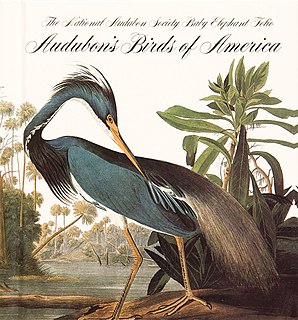
The Birds of America is a book by naturalist and painter John James Audubon, containing illustrations of a wide variety of birds of the United States. It was first published as a series in sections between 1827 and 1838, in Edinburgh and London. Not all of the specimens illustrated in the work were collected by Audubon himself; some were sent to him by John Kirk Townsend, who had collected them on Nathaniel Jarvis Wyeth's 1834 expedition with Thomas Nuttall.

Audubon National Wildlife Refuge is a 14,739-acre (5,965 ha) National Wildlife Refuge in the U.S. state of North Dakota. The refuge is managed by the U.S. Fish and Wildlife Service and is the centerpiece of the Audubon National Wildlife Refuge Complex, which includes numerous other refuges in the region. Originally designated as the Snake Creek National Wildlife Refuge in 1955, the refuge was renamed in 1967 in honor of the artist and naturalist John James Audubon. Most of the refuge area is a lake known as Audubon Lake which is managed by the U.S. Army Corps of Engineers.

John James Audubon State Park is located on U. S. Route 41 in Henderson, Kentucky, just south of the Ohio River. Its inspiration is John James Audubon, the ornithologist, naturalist, painter, and slaveowner who resided in Henderson from 1810 to 1819 when Henderson was a frontier village.
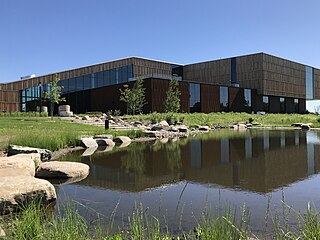
The Bell Museum, formerly known as the James Ford Bell Museum of Natural History, is located at the University of Minnesota. The museum's new location on the St. Paul campus opened July 13–15, 2018. The world-renowned Minnesota wildlife dioramas, numerous animal specimens from all over the world, and the 120-seat digital Whitney and Elizabeth MacMillan Planetarium theater are highlighted features of the new facility. The museum's former location in Minneapolis is closed as the work to move to the University of Minnesota's St. Paul campus began in January 2017. The museum is part of the University's College of Food, Agricultural and Natural Resource Sciences.

The Connecticut Audubon Society Birdcraft Museum and Sanctuary, also known as Birdcraft Museum & Sanctuary or simply Birdcraft Sanctuary, in Fairfield, Connecticut is the oldest private songbird sanctuary in the United States. It was established in 1914 by Mabel Osgood Wright.

The Fairbanks Museum & Planetarium is a combination natural science museum, history museum, and planetarium located in St. Johnsbury, Vermont. It was founded in 1890 by businessman, politician, naturalist, and collector Franklin Fairbanks. The museum and its buildings are on the U.S. National Register of Historic Places.
Bob Spear was an American naturalist, birdwatcher and master woodcarver who was the founding director of the Birds of Vermont Museum (BOVM), he was influential in the birding and environmental communities, having co-founded Vermont's first chapter of the National Audubon Society and having created more than 470 biologically accurate bird carvings on display at the BOVM. He was also the author of the book, The Birds of Vermont, published in 1969 by the Green Mountain Audubon Society. He resided in Huntington, Vermont United States.
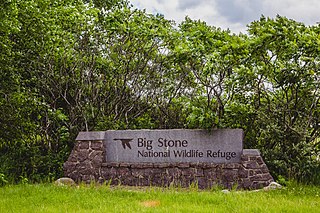
Straddling the headwaters of the Minnesota River in west-central Minnesota, Big Stone National Wildlife Refuge is within the heart of the tallgrass prairie's historic range. Today, less than one-percent of tallgrass prairie remains.

The Indonesia Museum, is an anthropology and ethnological museum located in Taman Mini Indonesia Indah (TMII), Jakarta, Indonesia. The museum is concentrated on arts and cultures of various ethnic groups that inhabit Indonesian archipelago and formed the modern nation of Indonesia. The museum is a richly decorated building in Balinese architecture. The museum boasts a comprehensive collection consisting of over 1,000 pieces of traditional and contemporary Indonesian arts, crafts and traditional costumes from the different regions of the nation.

The Natural History Museum of Bern is a museum in Bern, Switzerland. In its teaching and research it cooperates closely with the University of Bern. It is visited by around 131,000 people yearly.

The Fleming Museum of Art is a museum of art and anthropology at the University of Vermont in Burlington. The museum's collection includes some 25,000 objects from a wide variety of eras and places. Until 2014, the museum was known as the Robert Hull Fleming Museum.




















